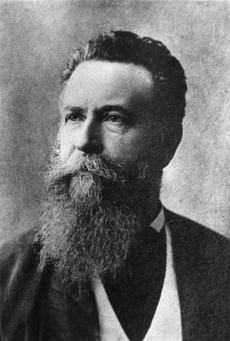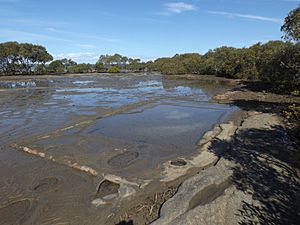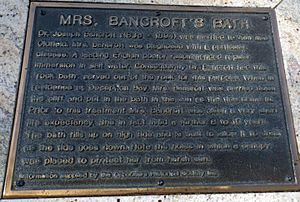Deception Bay Sea Baths facts for kids
Quick facts for kids Deception Bay Sea Baths |
|
|---|---|
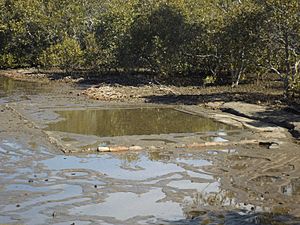
Fisheries Bath, 2016
|
|
| Location | Captain Cook Parade, Deception Bay, City of Moreton Bay, Queensland, Australia |
| Design period | 1870s–1890s (late 19th century) |
| Built | 1880s–1890s |
| Official name: Deception Bay Sea Baths, Bancroft Sea Baths | |
| Type | state heritage (archaeological, built, landscape) |
| Designated | 4 July 2006 |
| Reference no. | 602509 |
| Significant period | 1880s–1890s (historical) |
| Significant components | swimming/bathing enclosure, boardwalk, steps/stairway |
| Builders | Joseph Bancroft |
| Lua error in Module:Location_map at line 420: attempt to index field 'wikibase' (a nil value). | |
The Deception Bay Sea Baths are special old swimming pools located at Captain Cook Parade in Deception Bay, Queensland, Australia. They are carved into the sandstone along the foreshore. These baths were likely built by a famous scientist named Joseph Bancroft in the 1880s or 1890s.
Sometimes, they are also called the Bancroft Sea Baths. Because of their history and unique design, they were added to the Queensland Heritage Register on July 4, 2006. This means they are protected as an important part of Queensland's past.
Contents
A Dip into History
The Deception Bay Sea Baths are actually two rectangular pools dug into the sandstone. You can find them on the Deception Bay foreshore, which is the area where the land meets the sea.
One bath is called the Fisheries Bath. It's about 4.3 meters long and 2.7 meters wide. This bath is in the "inter-tidal zone," which means it's covered by water at high tide and exposed at low tide. It's about 20 meters east of the Southern Fisheries Centre.
The other bath is the Boardwalk Bath. It's smaller, about 3 meters long and 1.8 meters wide. This one is close to the foreshore boardwalk. People believe Joseph Bancroft built both of these baths in the late 1800s.
Who Was Joseph Bancroft?
Joseph Bancroft was born and educated in England. He moved to Queensland in 1864 and worked as a doctor in Brisbane. But he wasn't just a doctor; he and his son, Thomas, were also very interested in science. They became well-known scientists in Queensland.
Joseph is remembered as one of the first people to do medical research in Australia. The Bancroft Centre at the Queensland Institute of Medical Research is named after him. He led many early science and medical groups in Queensland.
Both Joseph and Thomas made huge discoveries in science. They studied insects that affect plants and plant diseases. They also made important findings about parasites. They were keen naturalists, meaning they loved studying nature. They found many new types of animals and plants. In fact, thirteen Australian native plants are named after them!
They became famous around the world for Joseph's discovery of a tiny worm called Wuchereria bancrofti. This worm causes a disease called elephantiasis, which makes body parts swell up. Later, Thomas found out that this worm was spread by the Aedes aegypti mosquito. Much of their important research happened at their property in Deception Bay.
Bancroft's Life at Deception Bay
Joseph Bancroft owned land at Deception Bay by the early 1880s. By 1890, he owned a large area of about 1500 hectares (that's like 3,700 football fields!). He lived in Brisbane but visited his Deception Bay property with his family on weekends and holidays.
At the bay, he raised cattle and even started a factory to make dried beef. He also tried growing rice and experimenting with how to grow pearls. Most importantly, he used the property as a research station for his studies on plants and animals.
After Joseph passed away in 1894, his son Thomas took over the dried beef factory. Thomas and his wife, Cecilia, moved to Deception Bay. It was here that Thomas made his big discovery about how mosquitoes spread the Wuchereria bancrofti worm. The dried beef factory eventually closed in 1904, and Thomas moved back to Brisbane.
Why Were the Baths Built?
The Bancroft family believes that Joseph built the baths. Family stories say that Joseph's wife, Ann, had a long-term illness. Joseph shaped the Boardwalk Bath from natural tidal pools for her because she found that bathing in the sea helped her feel better. This makes sense because the Boardwalk Bath is quite small.
The larger Fisheries Bath might have been used by the Bancrofts for fun. At low tide in Deception Bay, there's a lot of mud between the shore and the water. A visitor's memories from that time suggest that Joseph dug this bath so he could swim even when the tide was out. An old family photo also shows a woman, believed to be Joseph's half-sister, with her son next to the Fisheries Bath in the late 1800s.
In the 1800s, people started to see the seaside as a place for both fun and health. Many believed that sea bathing was good for you. People would go to the beach to escape busy city life. Often, special netted areas or tidal baths were built to create safe swimming spots.
The Deception Bay tidal baths are thought to be the only surviving baths of their kind from the 1800s in Queensland.
Later Uses
After the Bancrofts, the Dunne brothers bought some of the land in the early 1900s. They raised dairy cows, grew crops, and even farmed oysters along the foreshore. You can still see oyster remains on the sides of the Fisheries Bath, which suggests the Dunne brothers might have used it for growing shellfish.
Because the baths are in the inter-tidal zone, they often fill up with mud and sand. They have been dug out and cleaned many times over the years. In 2004, experts carefully studied and recorded each bath.
What Do They Look Like?
Boardwalk Bath Details
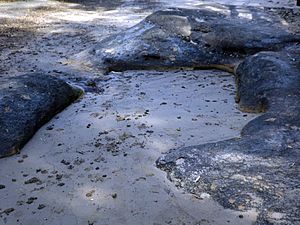
This bath is part of a sandstone rock formation that's about 10 meters long and 5 meters wide. The rock rises about 1 meter above the sand. On one side of the rock is a raised wooden boardwalk, and on the other side are many mangrove trees.
The bath itself is a rectangle cut into the sandstone. It's 3 meters long and 1.8 meters wide. The bottom of the bath has a thin layer of cement. You can still see marks from the hand tools used to dig it out.
The northern end of the bath has natural sandstone and a small brick wall. This wall is about 36.5 centimeters high (five layers of bricks). At the bottom of the brick wall, there's a small drainpipe, about 5 centimeters wide, to let water out. The inside of the brick wall forms three steps.
Fisheries Bath Details
This bath is a rectangle, 4.3 meters long and 2.7 meters wide. It has a triangular shape sticking out on its eastern side. This triangular part leads to a curved ledge inside the bath. The sides of the bath are mostly straight down, about 1 meter deep. The bottom of the bath slopes down to its deepest point, which is about 1.3 meters deep.
There's a brick edge around the south, east, and north sides of the bath. These bricks are set into a shallow trench in the sandstone with a type of cement. The bricks are quite worn down now.
Three postholes (holes where posts once stood) are cut into the sandstone around the bath. These holes are about 25 centimeters wide. On the western side, a sandstone platform marks the edge of the bath area.
On the southern side of the bath, there's a shallow trough, about 7 centimeters deep, 2.9 meters long, and 25 centimeters wide. Notches for wooden steps are on the northern edge. After the 2004 study, the old wooden steps were left in the bath.
Why Are They Heritage-Listed?
The Deception Bay Sea Baths were added to the Queensland Heritage Register on July 4, 2006, because they meet several important rules.
They show how Queensland's history has changed. The baths are important because they show us how people used the seaside in Queensland in the late 1800s. They were used for both fun and for health reasons. The Bancroft family and local community stories tell us that the Bancrofts built and used them for swimming and to help Ann Bancroft's long-term illness.
They are rare and special. These baths are uncommon examples of sea baths from the 1800s. They are likely the only ones of their kind still existing in Queensland. They were dug out of the sandstone in the area between high and low tide and filled naturally by the ocean. The Boardwalk Bath even had a pipe to drain the water.
They show what sea baths are like. The baths are great examples of what sea baths should look like and are still in very good condition. Like other tidal baths in Australia, they were made by improving natural rock formations in the inter-tidal zone. The Boardwalk Bath uses an artificial wall to close off one end of a natural pool. Both pools fill up with the tide, and the Boardwalk Bath drains through a pipe.
They are connected to important people. Both baths are strongly linked to Joseph Bancroft and his son Thomas, who are believed to have built and used them. Joseph and Thomas were very important scientists in Queensland in the late 1800s and early 1900s. Joseph is known as a founder of medical research in Australia. Both men made big contributions to studying plants, animals, and medicine. They became famous worldwide for Joseph's discovery of the Wuchereria Bancrofti worm and Thomas's discovery that mosquitoes spread it. The Bancroft memorial lecture and medal, and the Bancroft Centre, are named in Joseph's honor.


